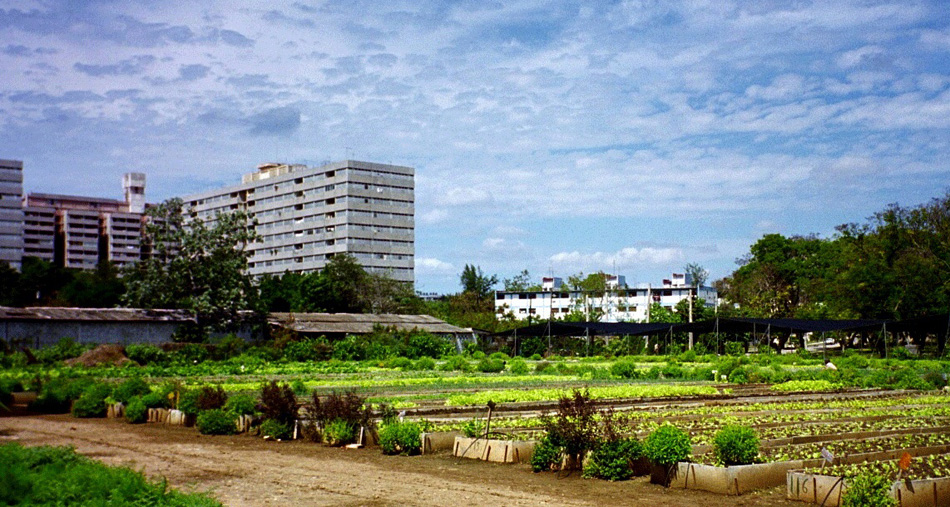
CAMBRIDGE, Mass.—Imagine living in a town surrounded by ecologically friendly farms; walkable, green, with world-class cultural and health institutions, and flexible working schedules allowing you to get your hands dirty and exercise by working on a farm in the morning and studying, creating art, or playing with your children in the afternoon.
Envision a comfortable, well-constructed, and re-purposed rural town, devoted to growing the highest quality produce and food products, with the least amount of chemicals, packaging, and transportation costs. If you get the picture, you’re beginning to understand the idea of an “agrotown.”
Agrotowns were first developed by the USSR in the 1930s as a rural development planning model, initially based on ancient agglomerations of agricultural workers prevalent in the Mediterranean basin. Soviet agrotowns were designed to combine food production with the industrial and cultural facilities of a city.
In a forthcoming article to be published by Routledge in International Critical Thought, the Journal of the Chinese Academy of Social Sciences (CASS), I review a selection of research and historical resources on agrotowns which explores early examples and provides evidence that if these towns are correctly planned, they can play a vital role in the implementation of agroecology and other sustainable development planning goals.
Thanks to the work of the late Richard Levins at the Harvard School of Public Health, and Wadhi’h Halabi of the Center for Marxist Education in Cambridge, Massachusetts, there is revived interest in agrotowns as a part of ongoing work on agroecology and sustainable development.
Agroecology
Twenty-first century agrotowns, however, would not simply be attractive centers for reviving agriculture and rural populations. First and foremost, agrotowns would address the life-threatening ecological crises facing humanity and our natural environment.
Richard Levins was a Marxist scientist and a pioneer in the field of ecological agriculture. For more than half a century, he was a researcher of mathematical ecology and served as a professor at Harvard, the University of Puerto Rico, and the University of Havana, among other prestigious institutions.
Before his death in January 2016, Levins was able to make important connections for the development of agroecological principles and humanity’s future. One of these connections was a close working relationship—and friendship—with Halabi at the Center for Marxist Education. Halabi, a Palestinian-born member of the Economics Commission of the Communist Party USA, has been sharing their collaborative work with U.S., Chinese, and Cuban students, workers, and leadership for more than a decade.
Most recently, Halabi made a plug for agrotown development at the Second World Cultural Forum of the Chinese Academy of Social Sciences in Beijing in October 2017. He addressed what will be necessary to attract younger people back to agriculture after a socialist revolution.
In Halabi’s words, “The answers can provide the foundations for a new culture, and an ecological civilization.” He raised the potential importance of agrotowns to future sustainable development efforts more than once, arguing:
“Analysis of human needs makes it increasingly clear that the solutions to agricultural production after a socialist revolution will require something like the ‘agrotowns’ proposed and in some cases developed in the Soviet Union by planners and agriculturalists. Agrotowns combined agricultural production with the industrial, educational, cultural, health care, and other facilities of cities.”
Halabi and Levins agreed that agrotowns, as developed in states such as China and Cuba, could provide guidance for the “new land reform” desperately needed for national liberation and the transition from capitalism to socialism.
Indeed, any discussion of the future of humanity must address the world’s most populous country, which at over 1.4 billion, is China. Roughly 20 percent of the entire population of the globe lives within the borders of the People’s Republic of China, a state formed by a socialist revolution in 1949. But it was on the Caribbean island of Cuba that Levins saw a glimpse of a future based on agroecological and socialist principles.
In a 2005 paper, “How Cuba is going ecological,” in Capitalism, Nature, Socialism, Levins wrote:
“[E]ach kind of society develops its own relations with the rest of nature, and…an ecological pathway of development is at least latent in socialist development, co-equal with equity and participation. Despite all the zigzags, vacillations, and disputes, it emerges as an increasingly central characteristic. And this is imperative, for socialism cannot succeed without committing to an ecological pathway. Indeed, the failure of the Soviet Union and eastern Europe to do so was one symptom of the disintegration of the European socialist project.”
Of course these pathways, as Levins coined them, must primarily address hunger and poverty eradication, health care, and scientific advancement. At first, Halabi says, “It’s making the best of a bad situation.” But with time, the age-old contradictions between town and country can and do wither away, stripping layer after layer of the culture of exploitation characteristic of capitalism.
Within this context, agrotowns may make a significant contribution to both rural development and the overall development objectives of countries like China and Cuba to raise their people out of poverty and into being advanced and sustainable societies.
Challenges
The development of a comprehensive model for both rural and urban planning using agroecological principles faces a complex and interdependent set of challenges, especially if this is to be adopted by Chinese planners and agriculturalists.
In January 2017, the State Council and the Central Committee of the Communist Party of China issued their “No. 1 Central Document,” which focused on agriculture, rural communities, and farmer-related topics for the fourteenth consecutive year. The No. 1 document is traditionally the government’s most important policy focus for the year.
According to the Ministry of Agriculture,
“[T]he document vowed ‘marked progress’ in agriculture by 2020 to ensure society becomes moderately prosperous. Upholding an innovative, coordinated, green, open, and shared development concept, the authorities called for faster transformation of agricultural models.”
Major policy initiatives are also aimed at improving the infrastructure of agriculture, supporting green production, extending agro-industrial value chains, enhancing innovation, consolidating shared rural development, and augmenting other rural reforms—including attracting younger people to return to their rural hometowns.
With this important emphasis on China’s agricultural development, the time is right to begin an interdisciplinary effort to develop a comprehensive model or toolbox for planners to begin working to implement agrotowns based on agroecological principles.
Donald Donato will be giving a presentation on agrotowns and agroecological pathways to development at the Center for Marxist Education in Cambridge, Mass. on Saturday, Jan. 20 at 3 p.m. Information is available here.












Comments